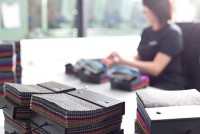AN INTERMITTENT HISTORY OF THE HUDDERSFIELD TEXTILE SOCIETY FROM 1935 TO 2012

MEMBERSHIP
Over the 24-year period covered by the Journals, membership fluctuates, but was always over 200, apart from the first session after the War (1945-6), when total membership was 185, with 84 individual members. Despite this, the average attendance at meetings was 150!
Company membership rose steadily from 56 in 1936-7 to 135 in 1956-7 and this figure included banks. Individual membership was 136 in 1935-6, fell to 84 (see above) and then rose to reach 259 in 1958-9. Total membership rose from 264 in 1935-6 to 391 in 1958-9. The Journal of 1936-7 reports that there were 63 vice-presidents in that year, compared to 62 the year before. Could these have been non-paying members? This sub-division is not repeated in any subsequent Journal.
GENERAL COMMENTS
In 1934-5, the mayor of Huddersfield was asked to be President of the Society for 1935-6, but declined the offer. The mayor and Council were invited to the AGM, but the mayor was unable to attend. In the same year, Messrs Wheawill and Sudworth were asked to act as Hon Auditors, a position they still hold nearly 80 years later.
Some issues never change: in 1936-7, the Hon Secretary in his notes bemoaned the fact that only 66% of members had paid their subscriptions (there are no details of the size of subscriptions in any Journal). In the 1955-6 Journal, the Hon Secretary appealed to members for old Journals and membership cards to be given to him as several were missing!
In Society minutes in the late 1930s, it was noted which lecturers to the Society asked for fees. These were usually 1 or 2 guineas; some speakers asked only for expenses. The highest fee noted, 5 guineas, was requested by a lecturer from Leeds University.
Prizes were awarded in:
• Woollen yarn manufacture
• Worsted yarn manufacture
• Waving and designing
• Cloth finishing.
Prizes continued to be awarded in these categories until 1958-9.
Small exhibitions were held in association with AGMs at this time. Brook Taverner showed samples while, for several years after the war, students at the Technical College showed their ‘patterns’.
In 1938-9, it was decided to award an honorarium of £5 per annum to the Secretary. £150 of War Stock was purchased that year (at 3½%) on behalf of the Society.
The Second World War caused a cessation of the Society’s activities. A full programme of lectures had been agree to but, at the Committee Meeting of 21 September 1939 (less than 3 weeks after the outbreak of war) the advisability of cancelling lectures was discussed in view of the ‘prevailing conditions’. It was agreed to suspend all activities until further notice, including not renewing subscriptions. The next meeting of the Society did not take place until 25 March 1946, 6½ years later.
At the 1946 AGM, vouchers were presented to students who had been awarded Textile Society medals during the war years: the vouchers were to be exchanged for medals when these became available. It was noted that some medallists were still serving and could not attend the meeting. The vouchers were forwarded to them.
The 1945-6 Journal reported a visit made by Guy Crowther (President) to Germany, as a member of the Woollen and Worsted Manufacturers’ Panel, whose instruction was to survey ‘our’ branch of German industry in all its aspects. He referred to people on the streets looking “sallow in colour and drab in clothing; such shops as there were had little to offer. However, he was more optimistic about the prospects of the German wool textile industry.
A notable innovation took place in 1946-7: the first recorded lecture given by a woman. However, this ‘experiment’ was not repeated for many years.
It was noted in the minutes of the 1947 AGM that ‘some very enjoyable entertainment was provided at intervals by 3 artistes engaged for the evening’. This initiative continued for three more years.
The society agreed to purchase a typewriter (the cost being £36-38) for typing the Society’s correspondence. The Presidents of the Dewsbury, Halifax and Bradford Textile Societies were invited to the AGM, at which the International Wool Secretariat (IWS) provided a small exhibition. At the 1951 AGM, ICI Fibres was invited to provide an exhibition of fibres, including Terylene and Ardil.
The 1948-9 Journal reported the address by the President (Fred Haigh – also Chairman of the Wool Textile Delegation) at the annual dinner on:
• Exports
• Nationalisation
• Standards of manufacture
• Presentation and labelling
It was agreed that year that the Journal should be mainly a record of the lectures for members to keep as a record. Committee members said the ‘over elaboration was unnecessary’. The cost of advertising in the Journal was 30s for one page and £2 for 2 pages.

